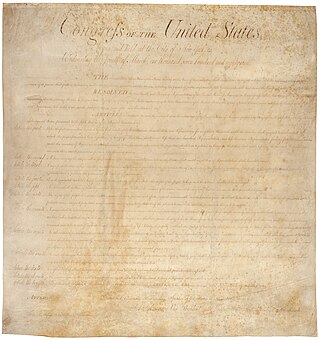United States Constitution
Freedom of religion
The text of Amendment I to the United States Constitution, ratified December 15, 1791, states that:
"Congress shall make no law... prohibiting the free exercise thereof;" [8]
— United States Constitution, Amendment I
Freedom of expression
Free Speech Clause
The text of Amendment I to the United States Constitution, ratified December 15, 1791, states that:
"Congress shall make no law... abridging the freedom of speech," [8]
— United States Constitution, Amendment I
Free Press Clause
The text of Amendment I to the United States Constitution, ratified December 15, 1791, states that:
"Congress shall make no law... abridging... the press," [8]
— United States Constitution, Amendment I
Free Assembly Clause
The text of Amendment I to the United States Constitution, ratified December 15, 1791, states that:
"Congress shall make no law... abridging... the right of the people peaceably to assemble," [8]
— United States Constitution, Amendment I
Petition Clause
The text of Amendment I to the United States Constitution, ratified December 15, 1791, states that:
"Congress shall make no law... abridging... the right of the people... to petition the Government for a redress of grievances." [8]
— United States Constitution, Amendment I
Free speech exceptions
The following types of speech are not protected constitutionally: defamation or false statements, child pornography, obscenity, damaging the national security interests, verbal acts, and fighting words. Because these categories fall outside of the First Amendment privileges, the courts can legally restrict or criminalize any expressive act within them. Other expressions, including threat of bodily harm or publicizing illegal activity, may also be ruled illegal. [9]
Right to keep and bear arms
The text of Amendment II to the United States Constitution, ratified December 15, 1791, states that:
"A well regulated Militia, being necessary to the security of a free state, the right of the people to keep and bear Arms, shall not be infringed." [8]
— United States Constitution, Amendment II
Sexual freedom
The concept of sexual freedom includes a broad range of different rights that are not mentioned in the U.S. Constitution. The idea of sexual freedom has sprung more from the popular opinion of society in more recent years, and has had very little Constitutional backing. The following liberties are included under sexual freedom: sexual expression, sexual choices, sexual education, reproductive justice, and sexual health. [10] Sexual freedom in general is considered an implied procedure, and is not mentioned in the Constitution.
Sexual freedoms include the freedom to have consensual sex with whomever a person chooses, at any time, for any reason, provided the person is of the age of majority. Marriage is not required, nor are there any requirements as to the gender or number of people you have sex with. Sexual freedom includes the freedom to have private consensual homosexual sex ( Lawrence v. Texas ).
Equal protection
Equal protection prevents the government from creating laws that are discriminatory in application or effect.
Right to vote
The text of Amendment XIV to the United States Constitution, ratified July 9, 1868, states that:
"when the right to vote at any election for the choice of electors for President and Vice President of the United States, Representatives in Congress, the Executive and Judicial officers of a State, or the members of the Legislature thereof, is denied to any of the
maleinhabitants of such State, beingtwenty-one(eighteen) years of age, and citizens of the United States, or in any way abridged, except for participation in rebellion, or other crime, the basis of representation therein shall be reduced in the proportion which the number of suchmalecitizens shall bear to the whole number ofmalecitizenstwenty-one(eighteen) years of age in such State." [8]— United States Constitution, Article XIV
The text of Amendment XV to the United States Constitution, ratified February 3, 1870, states that:
"The right of citizens of the United States to vote shall not be denied or abridged by the United States or by any State on account of race, color, or previous condition of servitude." [8]
— United States Constitution, Article XV
The text of Amendment XIX to the United States Constitution, ratified August 18, 1919, states that:
"The right of citizens of the United States to vote shall not be denied or abridged by the United States or by any State on account of sex." [8]
— United States Constitution, Amendment XIX
The text of Amendment XXIV to the United States Constitution, ratified January 23, 1964, states that:
"The right of citizens of the United States to vote in any primary or other election for President or Vice President, for electors for President or Vice President, or for Senator or Representative in Congress, shall not be denied or abridged by the United States or any state by reason of failure to pay any poll tax or other tax." [8]
— United States Constitution, Amendment XXIII
The text of Amendment XXVI to the United States Constitution, ratified July 1, 1971, states that:
"The right of citizens of the United States, who are 18 years of age or older, to vote, shall not be denied or abridged by the United States or any state on account of age." [8]
— United States Constitution, Amendment XXVI
Right to parent one's children
| | This section is empty. You can help by adding to it. (December 2021) |
The right to parent one's own children also includes the right for a parent to teach their children as they see fit, and not have others govern over what their children are taught.
Right to privacy
The Constitution of the United States and United States Bill of Rights do not explicitly include a right to privacy. [11] Currently no federal law takes a holistic approach to privacy regulation.
In the US, privacy and associated rights have been determined via court cases and the protections have been established through laws.
The Supreme Court in Griswold v. Connecticut, 381 U.S. 479 (1965) found that the Constitution guarantees a right to privacy against governmental intrusion via penumbras located in the founding text. [12]
In 1890, Warren and Brandeis drafted an article published in the Harvard Law Review titled "The Right To Privacy" that is often cited as the first implicit finding of a U.S. stance on the right to privacy. [13]
Right to privacy has been the justification for decisions involving a wide range of civil liberties cases, including Pierce v. Society of Sisters , which invalidated a successful 1922 Oregon initiative requiring compulsory public education; Roe v. Wade , which struck down an abortion law from Texas, and thus restricted state powers to enforce laws against abortion; and Lawrence v. Texas , which struck down a Texas sodomy law, and thus eliminated state powers to enforce laws against sodomy. Dobbs v. Jackson Women's Health Organization later overruled Roe v. Wade, in part due to the Supreme Court finding that the right to privacy was not mentioned in the constitution, [14] leaving the future validity of these decisions uncertain. [15]
Legally, the right of privacy is a basic law [16] which includes:
- The right of persons to be free from unwarranted publicity
- Unwarranted appropriation of one's personality
- Publicizing one's private affairs without a legitimate public concern
- Wrongful intrusion into one's private activities
For the health care sector where medical records are part of an individual's privacy, The Privacy Rule of the Health Insurance Portability and Accountability Act was passed in 1996. This act safeguards medical data of the patient which also includes giving individuals rights over their health information, like getting a copy of their records and seeking correction. [17] Medical anthropologist Khiara Bridges has argued that the US Medicare system requires so much personal disclosure from pregnant women that they effectively do not have privacy rights. [18]
CCPA [19]
In 2018, California set out to create a policy promoting data protection, the first state in the United States to pursue such protection. The resulting effort is the California Consumer Privacy Act (CCPA), reviewed as a critical juncture where the legal definition of what privacy entails from California lawmakers' perspective. The California Consumer Protection Act is a privacy law protecting the residents of California and their Personal identifying information. The law enacts regulation over all companies regardless of operational geography protecting the six Intentional Acts included in the law.
The intentions included in the Act provide California residents with the right to:
- Know what personal data is being collected about them.
- Know whether their personal data is sold or disclosed and to whom.
- Say no to the sale of personal data.
- Access their personal data.
- Request a business to delete any personal information about a consumer collected from that consumer.
- Not be discriminated against for exercising their privacy rights.
Right to marriage
The 1967 United States Supreme Court ruling in the case Loving v. Virginia found a fundamental right to marriage, regardless of race. The 2015 United States Supreme Court ruling in the case Obergefell v. Hodges found a fundamental right to marriage, regardless of gender.
Rights of self-defense
| | This section is empty. You can help by adding to it. (December 2021) |






